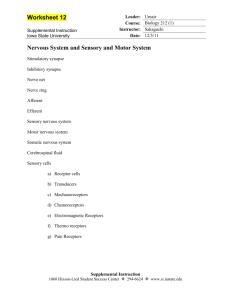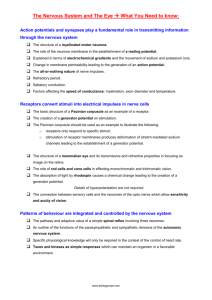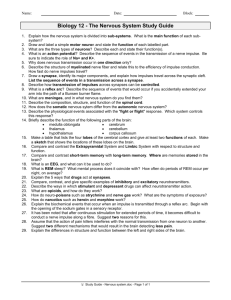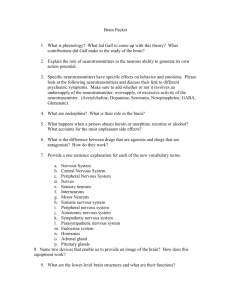neurobiology and communication1
advertisement
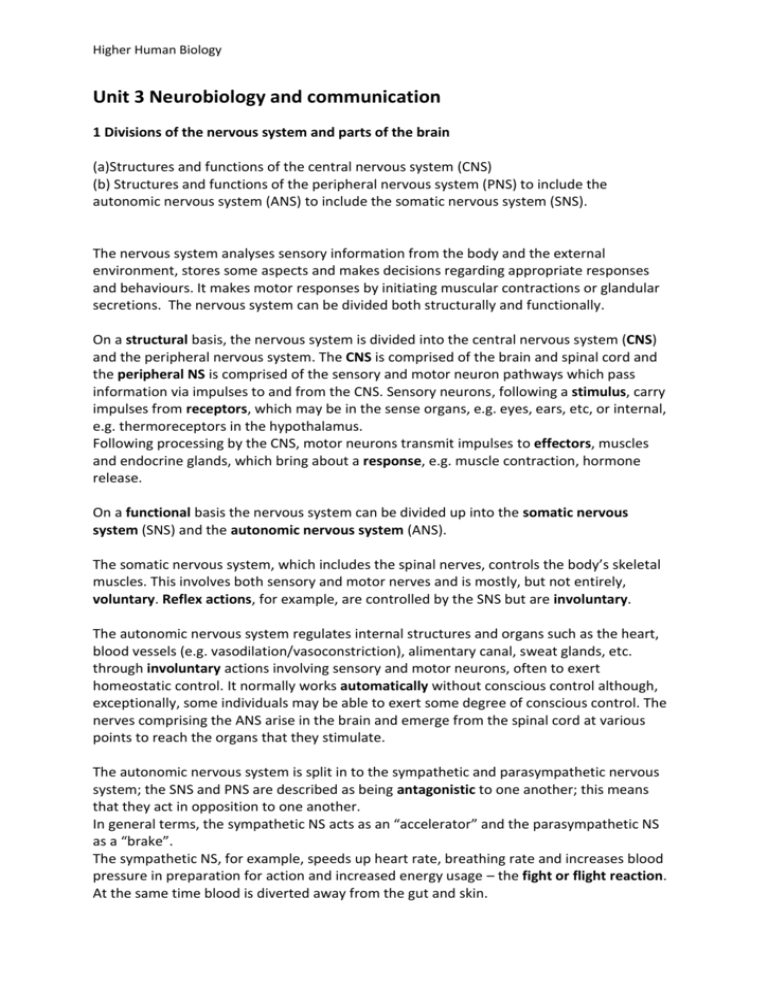
Higher Human Biology Unit 3 Neurobiology and communication 1 Divisions of the nervous system and parts of the brain (a)Structures and functions of the central nervous system (CNS) (b) Structures and functions of the peripheral nervous system (PNS) to include the autonomic nervous system (ANS) to include the somatic nervous system (SNS). The nervous system analyses sensory information from the body and the external environment, stores some aspects and makes decisions regarding appropriate responses and behaviours. It makes motor responses by initiating muscular contractions or glandular secretions. The nervous system can be divided both structurally and functionally. On a structural basis, the nervous system is divided into the central nervous system (CNS) and the peripheral nervous system. The CNS is comprised of the brain and spinal cord and the peripheral NS is comprised of the sensory and motor neuron pathways which pass information via impulses to and from the CNS. Sensory neurons, following a stimulus, carry impulses from receptors, which may be in the sense organs, e.g. eyes, ears, etc, or internal, e.g. thermoreceptors in the hypothalamus. Following processing by the CNS, motor neurons transmit impulses to effectors, muscles and endocrine glands, which bring about a response, e.g. muscle contraction, hormone release. On a functional basis the nervous system can be divided up into the somatic nervous system (SNS) and the autonomic nervous system (ANS). The somatic nervous system, which includes the spinal nerves, controls the body’s skeletal muscles. This involves both sensory and motor nerves and is mostly, but not entirely, voluntary. Reflex actions, for example, are controlled by the SNS but are involuntary. The autonomic nervous system regulates internal structures and organs such as the heart, blood vessels (e.g. vasodilation/vasoconstriction), alimentary canal, sweat glands, etc. through involuntary actions involving sensory and motor neurons, often to exert homeostatic control. It normally works automatically without conscious control although, exceptionally, some individuals may be able to exert some degree of conscious control. The nerves comprising the ANS arise in the brain and emerge from the spinal cord at various points to reach the organs that they stimulate. The autonomic nervous system is split in to the sympathetic and parasympathetic nervous system; the SNS and PNS are described as being antagonistic to one another; this means that they act in opposition to one another. In general terms, the sympathetic NS acts as an “accelerator” and the parasympathetic NS as a “brake”. The sympathetic NS, for example, speeds up heart rate, breathing rate and increases blood pressure in preparation for action and increased energy usage – the fight or flight reaction. At the same time blood is diverted away from the gut and skin. Higher Human Biology The parasympathetic NS slows down and reverses the actions of the sympathetic NS, heart rate and blood pressure return to normal, peristalsis resumes, intestinal secretions increase and blood flow to the gut increases – the rest and digest response. The effects of the parasympathetic nervous system help the body to conserve resources and store energy. (c) The functions of the medulla and cerebellum in the central core of the brain. The central core contains the medulla that regulates the basic life processes of breathing, heart rate, arousal and sleep and the cerebellum which is responsible for controlling balance, posture and movement. (d) The functions of the limbic system Functions include processing information for memories and influencing emotional and motivational states. (e) Cerebral cortex is the centre of conscious thought; it also recalls memories and alters decision making behaviour in the light of experience. The cerebral cortex also receives sensory information and coordinates voluntary movement. (f) Different parts of the cerebrum control different aspects of nervous function. The motor and sensory strips run across the top of the cerebrum with other areas of the cerebrum controlling language, personality, imagination and intelligence. Information from one side of the body is processed in the opposite side of the cerebrum, transfer of information occurs through the corpus callosum, a number of nerves which link the left and right hemispheres of the cerebrum. Higher Human Biology Some association areas deal with thought processes. The left cerebral hemisphere deals with information from the right visual field and controls the right side of the body and vice versa. 2 Perception and memory (a) Perception is the process by which the brain analyses and makes sense out of incoming sensory information. The three areas of perception involve segregation of objects, perception of distance and recognition. (i) Segregation of objects. When we view an object we firstly try to make sense of its shape. Any enclosed area represents an object which will stand out from its background. This is called the figure-ground phenomenon. The enclosed area appears to stand out from the background even though there is no depth to the image. The brain then tries to organise visual stimuli into coherent patterns, which can be altered by simple additions or substractions; the brains tries to form ordered relationships. Figure-ground phenomenon This is assisted by visual cues such as relative size, where objects appear to get smaller the further away they are, superimposition where objects that partially block the view of another are deemed to be nearer, and relative height in the field of view where closer objects appear to be lower down (have lower bases) than distant objects. (ii) Perception of distance. When we look at an object, each eye views the object from a slightly different position relative to the other eye. We therefore “see” a slightly different image with each eye. The closer the object, the greater the disparity (difference) between the two images. The brain merges the two images into one producing a binocular image which allows us to make an accurate judgement of depth and distance. This will have helped in hunting and is now important, for example, in sports. As objects become closer or further away from us the size of the image they make on out retinas will increase or decrease in size. We do not, however, perceive these objects as shrinking or increasing in size, they have size constancy. This depends partly on past experience and stored knowledge. (We know what size familiar objects are.) A similar process applies to shape; for example, as a door opens its shape appears to change from a rectangle to a trapezoid to a very small rectangle. We do not believe however, that the shape of the door has changed, it has shape constancy. This, too, depends on past experience and stored knowledge. Higher Human Biology (iii) Recognition. The ability to perceive an object’s physical properties such as shape, colour and texture is called object recognition. Of these properties shape is considered to be the most important in the recognition of objects. When a person perceives a shape a subconscious attempt is made to match the shape with one already stored in the brain. If not recognised it could then be recognised as being similar, but not identical to an image held in the brain. The brain then infers that the object is related in some way to one or more of these visual images. It could be a familiar object seen from a different angle. Perceptual set is the tendency of a person to perceive certain aspects of available sensory information and ignore others. Perceptual set is affected by expectation, context and past experience. It influences the way a stimulus is perceived. If a group of people are shown various pictures of young women and then the image alongside they will tend to see a young woman. If they are shown a series of pictures of old women then they will perceive an old woman. Young or old? (b) Memory as storage, retention and retrieval of information. All information entering the brain passes through sensory memory and enters short-term memory. Information is then transferred to long-term memory (LTM) or discarded. Memories include past experiences, knowledge and thoughts. (i) Sensory memory — lasts a few seconds and retains all of the visual or auditory input. Stimuli from the outside world are continuously being perceived as sensory images by the brain. These images are very short lived between 0.5 and 2 seconds. Only a few are selected and transferred to the short term memory. (ii) Short-term memory (STM). Short term memory allows us to remember information for a few seconds before it is replaced by more. Short term memory has a limited capacity, or memory span, it can retain about 7 pieces of information for about 30 seconds, e.g. a phone number or car number plate. If more items go into the STM they displace the previous items. More information can be retained in the STM if it is organised. Chunking can increase memory span by organising information of smaller units into a chunk e.g. telephone numbers can be chunked to give an area code which reduces 4 numbers to one piece of information—0141 for Glasgow, etc. Higher Human Biology Rehearsal involves repeating information to yourself many times. This extends the length of time the information is held in the STM and increases the chance that it will be transferred to the LTM. If information is not rehearsed the memory will decay and be forgotten. Serial position effect is where the first few and last few items from a string of facts are remembered best. The first few items are remembered as there has been time to rehearse them and they are now in the LTM. The last few are remembered because they are still in the STM. Working memory is an extension of the STM. It process, manipulates and controls information while held in the STM. This enables simple cognitive tasks to be carried out (iii) Long-term memory (LTM). LTM is thought to be able to hold an unlimited amount of information. During encoding the items are organised into categories such as personal facts and useful skills. The transfer of information from the short to long term memory happens upon successful encoding of the information in the STM. Once in the LTM it is then stored and may be retrieved at a later date. Successful transfer of information from the STM to LTM is promoted by rehearsal, organisation and elaboration of meaning. Rehearsal facilitates the transfer of information from the STM to the LTM. Organisation is where information is grouped or categorised in a way that is logical and meaningful to the learner. Elaboration is where facts are easier to transfer into the LTM if they are part of a bigger ‘story’, e.g. phosphofructokinase is easier to remember as part of the whole respiratory pathway than a single fact. Encoding is the conversion of one or more nerve impulses into a form that can be received and held by the brain and retrieved later from the STM or LTM. The quality of the memory is affected by the attention given to the task of encoding the material. Information encoded by repetition is an example of shallow encoding. Information encoded by linking it to previous memories is an example of elaborative encoding. Contextual cues aid the retrieval of information from the LTM. A contextual cue is a signal or reminder relating to the conditions or circumstances that were present at the time when the information was encoded into the LTM. (iv) Location of memory in the brain. Episodic (the memory of events and experiences) i.e. remembering that…., and semantic memory (the record of general knowledge, non-personal facts and concepts) are stored in the region of the cerebral cortex where the sensory information was first received and encoded. Procedural memories (skills) e.g. how to swim, how to read, are linked to the motor cortex. Emotional memories involve links between the cortex and the limbic system. Spatial memory is located in the limbic system and is responsible for holding information about a person’s environment and spatial orientation. Higher Human Biology 3 The cells of the nervous system. (a) Nerves are bundles of nerve fibres which carry electrical impulses from one part of the body to the other. Nerve cells or neurons consist of a nerve cell body and nerve fibres. The nerve cell body contains the nucleus and cytoplasm containing organelles including ribosomes which make various proteins including enzymes needed for the synthesis of neurotransmitters. Dendrites are nerve fibres that receive nerve impulses and carry them towards the cell body An axon is a nerve fibre which carries impulses away from the cell body. The direction in which a nerve impulse travels is always dendrite-cell body-axon. Long axon fibres are covered in a myelin sheath which insulates the axon and speeds up impulse conduction from node to node. Myelination is the development of myelin round axon fibres of individual neurons. Myelination is not complete at birth and so nervous control increases over the first two years as many more neurons are myelinated. Myelination continues from birth to adolescence. As a result responses to stimuli in the first two years of life are not as rapid or coordinated as those of an older child or adult. Certain diseases destroy the myelin sheath causing a loss of coordination. Motor neuron A motor neuron has short dendrites which make contact with other neurones in the CNS, a nerve cell body and a long myelinated axon that carries impulse to the many axon terminals within a muscle. Sensory neurons have one or several dendrites making contact with receptors in a sense organ, these merge to form a myelinated fibre which carries impulses to the cell body, a short axon and axon branches make contact with the CNS neurones. Sensory neuron An inter neuron connects a sensory and a motor neuron. Inter neuron Higher Human Biology Glial cells. Physically support neurons and produce the myelin sheath Glial cells also maintain a homeostatic environment around the neurones and remove debris by phagocytosis. (b) Neurotransmitters at synapses. Neurotransmitters relay messages from nerve to nerve within and outwith the brain. Neurones connect with other neurones, muscle fibres and endocrine at a synaptic cleft. Neurotransmitters are stored in vesicles and released into the cleft on arrival of an impulse. They diffuse across the cleft and bind to receptors on nerve endings. Neurotransmitters must be removed from the synaptic cleft to prevent continuous stimulation of post-synaptic neurones. Examples of neurotransmitters are acetylcholine and noradrenaline. Acetylcholine is broken down by an enzyme and the non active products are reabsorbed by the presynaptic neurone and resynthesised into active transmitter. Noradrenaline is reabsorbed directly into the presynaptic membrane and stored in a vesicle ready for reuse. Receptors determine whether the signal is excitatory or inhibitory. Synapses can filter out weak stimuli arising from insufficient secretion of neurotransmitters. Summation of a series of weak stimuli can trigger enough neurotransmitter to fire an impulse. (c) Function of converging, diverging and reverberating neural pathways. Converging path ways are where two or more neurones feed impulses to one neurone e.g. from rod cells in the eye. Converging neural pathways increase the sensitivity to excitatory or inhibitory signals. Diverging neural pathways mean that an impulse in one neurone can have a simultaneous effect in many parts of the body. Reverberating pathway neurones later in the pathway synapse with earlier ones sending the impulse back through the circuit. Higher Human Biology Plasticity of response is the ability of brain cells to become altered as a result of new environmental experiences. Plasticity of response enables new neural pathways to form during early development, when learning new skills and in response to brain injury. Major plasticity following brain damage is when undamaged cells form new neural pathways which take on the function of the damaged area. Minor plasticity is when the brain suppresses reflexes e.g. blinking or suppresses sensory impulses causing distraction from a task. (d) Neurotransmitters, mood and behaviour. The functions of endorphins and dopamine. Endorphins are neurotransmitters that stimulate neurones involved in reducing the intensity of pain. Increased levels are also connected with euphoric feelings, appetite modulation and release of sex hormones. Endorphin production increases in response to severe injury, prolonged and continuous exercise, stress and certain foods. Dopamine induces the feeling of pleasure and reinforces particular behaviour in the reward pathway. The reward pathway involves neurons which secrete or respond to the neurotransmitter dopamine. The reward pathway is activated on engagement of beneficial behaviours, e.g. eating when hungry. There are a number of disorders related to defects in neurotransmitters. Disorder Schizophrenia General anxiety disorders Cause Loss of cells synthesising acetylcholine. Loss of dopamine synthesising neurons. Overactive dopamine system Imbalance in serotonin and norepinephrin Depression Low levels of serotonin Alzheimer’s disease Parkinson’s disease Treatment Cholinesterase inhibitors Monamine oxidase inhibitors and the potential use of adult stem cells The use of dopamine antagonists The use of GABA agonists and beta blockers Norepinephrin re-uptake inhibitors and monoamine oxidase enzyme inhibitors Agonists bind to and stimulate receptors mimicking the neurotransmitter. Antagonists bind to specific receptors blocking the action of the neurotransmitter. Other drugs inhibit the enzymes which degrade neurotransmitters or inhibit re-uptake. Many drugs used to treat neurotransmitter related disorders are similar to neurotransmitters. (e) Mode of action of recreational drugs. Recreational drugs can mimic neurotransmitters. They cause changes in neurochemistry leading to changes in mood, cognition, perception and behaviour. Many recreational drugs affect neurotransmission in the reward circuit of the brain. Higher Human Biology Recreational drugs interact with neurotransmitters in different ways by stimulating the release of neurotransmitters, imitate their action (agonists), block their binding (antagonists), and/or inhibit their re-uptake/enzymatic degradation. Suitable case studies include: cocaine blocking dopamine re-uptake channels, cannabis binding to cannabinoid receptors, the synthetic hallucinogen MDMA (ecstasy) stimulating serotonin levels and inhibiting its re-uptake, alcohol binding to GABA receptors and elevating dopamine levels, nicotine activating nicotinic receptors increasing the levels of dopamine, serotonin and epinephrine. Drug addiction/tolerance. Drug addiction can be defined as a chronic disease that causes the sufferer to compulsively seek out and use the drug regardless of the consequences. As a result of the over stimulation of neuroreceptors by agonist drugs the brain reduces the number of receptors. The brain also reduces the sensitivity of the remaining receptors and a larger dose of the drug is now required to stimulate these receptors. These two responses by the brain cause desensitisation and lead to drug tolerance. The brain responds to antagonist drugs by increasing the number and sensitivity of neurotransmitter receptors and leads to addiction.

